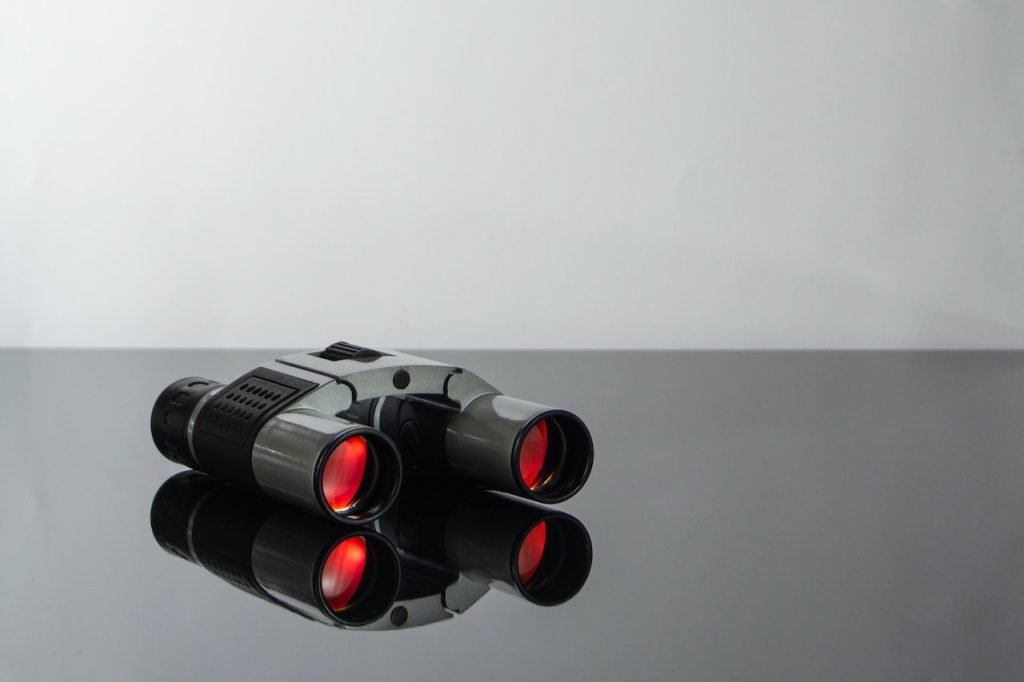Exploring the Purpose of Ruby Red Lenses in Binoculars
Are you curious about why some binoculars have red lenses?
If so, you’re in the right place. In this article, we’ll delve into the fascinating history and science behind the ruby coatings used in binoculars.
Did you know that red lenses were first developed for hunting purposes, but quickly became popular due to their cool and unique appearance?
Stick with us to learn more!
Let’s first learn about binoculars lenses.

The Science Behind Binocular Lenses
The lenses in binoculars play a critical role in image quality and clarity. Understanding the science behind binocular lenses is essential for selecting the right binoculars for your needs.
Types of Lenses Used in Binoculars
Binoculars typically use two types of lenses: objective lenses and eyepiece lenses.
Objective lenses are the larger lenses at the end of the binoculars that gather light and form the primary image. Eyepiece lenses are the smaller lenses that magnify the image formed by the objective lenses.
Objective lenses can be further classified into three types: achromatic lenses, apochromatic lenses, and fluorite lenses.
Achromatic lenses are the most common type used in binoculars. They correct the chromatic aberration of the lens, which is the tendency of the lens to separate white light into its colors.
Apochromatic lenses use multiple glass elements to correct for chromatic aberration and provide a sharper image. Fluorite lenses are made of calcium fluoride crystals and offer superior image quality and color reproduction.
Eyepiece lenses can be classified into two types: Plössl lenses and orthoscopic lenses.
Plössl lenses are the most commonly used eyepiece lenses in binoculars. They offer a wide field of view and are easy to manufacture.
Orthoscopic lenses are more expensive and offer a narrower field of view but produce sharper and clearer images.
How Lenses Affect Image Quality
The quality of the lenses in binoculars has a significant impact on image quality. High-quality lenses produce images with sharpness, clarity, and color accuracy.
The materials used in the lenses, the precision of the lens manufacturing process, and the coatings applied to the lenses all affect image quality.
The size of the objective lenses also affects image quality. Larger objective lenses allow more light to enter the binoculars, resulting in brighter images.
However, larger objective lenses also increase the weight and size of the binoculars, making them less portable.
Role of Coatings and Filters in Lenses
Lenses in binoculars are often coated with anti-reflective coatings to reduce glare and improve contrast. The coatings also protect the lenses from water droplets stickiness, scratches and abrasions.
The type and quality of the coatings used on the lenses affect the amount of light that passes through the lenses and the quality of the image produced.
Filters can also be added to the lenses of binoculars to enhance specific colors or reduce glare.
For example, green filters can enhance the color green in nature, while red filters can enhance the color red. These filters can be particularly useful in certain lighting conditions, such as low-light or bright sunlight.
Ruby Red Lenses in Binoculars
Steiner Optics was the first to introduce “Ruby” lens coatings on their binoculars. These optics were developed for steiner hunting line binoculars. The red filtering in these coatings helps to effectively cut through haze, as well as increase the contrast between game animals and foliage, resulting in improved visibility for hunters.
However, some manufacturers of lower-quality binoculars have copied the red coating for its aesthetics, without providing the same functionality.
This copying was done on a large scale as the appeal of red lenses in binoculars grew due to their flashy and cool appearance, which many people find attractive.
However, these coatings can often degrade the performance of the binoculars.
Also,
Some low-cost binoculars may feature other colours such as blue, or green mirror finish as a way to appear more attractive to uninformed buyers.
Originally intended to conceal poor workmanship and defects, these coatings are now marketed with exaggerated claims about preventing flare or glare, which are simply not true.
In reality, these coatings are more harmful than beneficial, as they actually degrade the performance of the binoculars.
How to Determine if Binoculars Have High-Quality Coatings
An anti-reflection coating in binoculars can reduce reflection and may result in a faint colored reflection on the surface of the lens.
This is because the coating is designed to reflect certain wavelengths of light more effectively than others, which can result in a slight color shift in the reflected light.
This is not a bad thing, as it indicates that the anti-reflection coating is applied (effective lens treatment is done) on binoculars and is working effectively to reduce reflection and improve image quality. This also indicates that binoculars are of high quality
Conclusion:
While the idea of using ruby red coatings on binoculars to minimize color aberrations may seem promising, the reality is not so straightforward.
While optics with ruby red coatings may initially appear to perform better, upon closer examination, they may produce an unnatural greenish tint and appear washed out compared to their counterparts with “normal” coatings.
Therefore, it is important to carefully evaluate the trade-offs before deciding if ruby red binoculars are the best option for your needs.
We would suggest going for normal fully coated binoculars instead of red or ruby-coated binoculars.
More Read:
